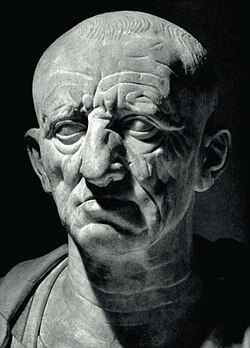This article needs additional citations for verification .(March 2023) |

Bust No. 535 of the Torlonia Collection, also called the Patrician Torlonia or the Old Man of Otricoli [1] , is a marble bust, [2] sometimes said to portray Marcus Porcius Cato Censorius, though also noted as being of "an unknown Roman politician". [3] It is a copy of a Tiberian era bust (1st century AD), itself thought to be a copy of an original dating from around 80–70 BC. The piece is executed in the late republican portrait style later known as verism, which "emphasize[s] the physical signs of aging... as evidence of an individual's experience, character, and virtues". [4]
Contents
The Patrician was added to the Torlonia Museum as part of a gallery of busts depicting famous Romans "from Marius to the heirs of Constantine". [5] A catalog of 1884/5 says that the portrait was discovered at Otricoli and identifies its subject as Galba; there is no corroborating evidence for the findspot, and the identification is certainly incorrect, perhaps motivated by the need for a portrait of Galba to fill a gap in the collection. [5] The body of the bust, including the front of the neck, is a modern assemblage, possibly incorporating ancient fragments, [1] while the head is ancient, except for repairs to the right ear and the tip of the nose. [5]



